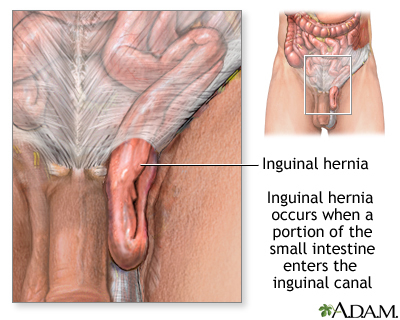Inguinal Hernia
Original Editors - Lindsey Roederer and Stephanie McCauley from Bellarmine University's Pathophysiology of Complex Patient Problems project.
Lead Editors - Your name will be added here if you are a lead editor on this page. Read more.
Definition/Description[edit | edit source]
Prevalence[edit | edit source]
The most common hernia for males and females is the inguinal hernia. Approximately 25% of males and 2% of females have an inguinal hernia during their lifetime. Furthermore, indirect inguinal hernias are more common in both sexes than direct hernias. Children can also have an inguinal hernia. The incident rate for children ranges up to 4.5%.
In the United States, over 1 million abdominal hernia repairs are performed each year. Of those 1 million repairs, it is estimated that 770,000 of them are inguinal hernia repairs. Males receive 90% of all inguinal hernia repairs.[2]
Characteristics/Clinical Presentation[edit | edit source]
add text here
Associated Co-morbidities[edit | edit source]
• Congenital abdominal weakness
• Chronic constipation
• Chronic cough
• Enlarged prostate
• Cystic fibrosis
• Overweight or obesity
• Ascites
• Smoking
• Overexertion
• Undescended testicles
• Any condition that increases pressure on the abdominal wall
Medications[edit | edit source]
add text here
Diagnostic Tests/Lab Tests/Lab Values[edit | edit source]
add text here
Etiology/Causes[edit | edit source]
add text here
Systemic Involvement[edit | edit source]
add text here
Medical Management (current best evidence)[edit | edit source]
add text here
Physical Therapy Management (current best evidence)[edit | edit source]
add text here
Alternative/Holistic Management (current best evidence)[edit | edit source]
add text here
Differential Diagnosis[edit | edit source]
add text here
Case Reports/ Case Studies[edit | edit source]
add links to case studies here (case studies should be added on new pages using the case study template)
Resources
[edit | edit source]
add appropriate resources here
Recent Related Research (from Pubmed)[edit | edit source]
see tutorial on Adding PubMed Feed
Failed to load RSS feed from http://eutils.ncbi.nlm.nih.gov/entrez/eutils/erss.cgi?rss_guid=1NGmwZeh8JwVIzrKgHG1LrDm0izTr7ViJiDkSYAY2BW5hiXsx0|charset=UTF-8|short|max=10: Error parsing XML for RSS
References[edit | edit source]
see adding references tutorial.
- ↑ Inguinal Hernia. PubMed Health. Available at: http://www.ncbi.nlm.nih.gov/pubmedhealth/PMH0001956/
- ↑ Medscape Reference. Hernias. http://emedicine.medscape.com/article/775630-overview#a0199 (accessed 8 February 2013)







